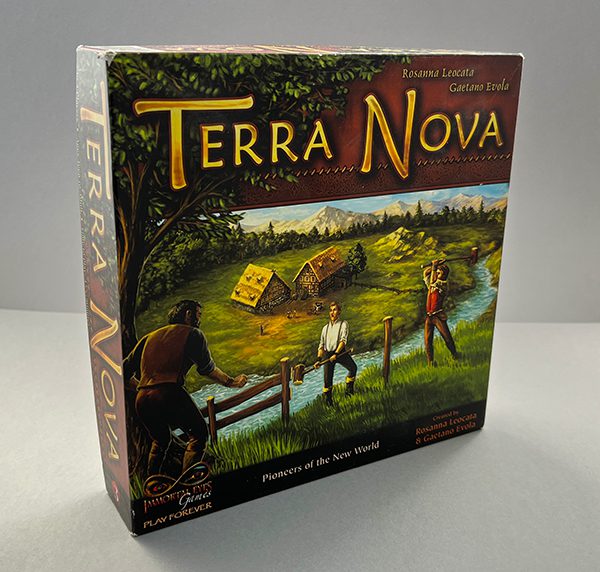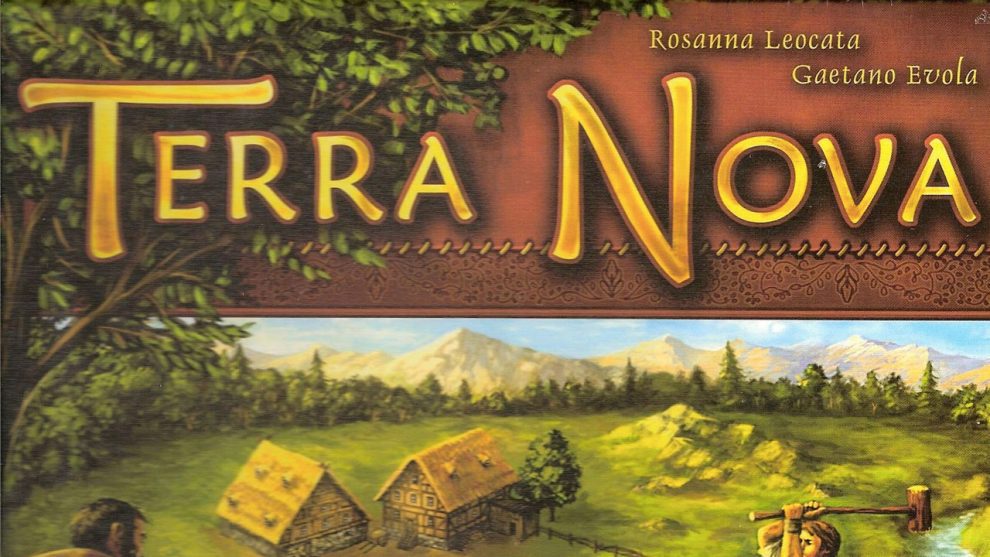Recently, KOSMOS and Capstone Games announced a pared-down version of the Meeple Mountain favorite, Terra Mystica. Named Terra Nova, this version makes use of a smaller board and smaller player mats, condensing the game down from 2+ hours to a brisk ninety minutes. However, a review of that game will have to wait until it hits the shelves later this year.
Seeing the name reminded me of another game with the same name. Back in 2006, designers Gaetano Evola and Rosanna Leocata launched their Terra Nova. This version is an area control game where your Pioneers will go out to explore an island and fence off land for victory points.

Set Up
Start by setting the board and the hex pieces out in easy reach of all players. Then give each player the Pioneers in their chosen color, using only the number for your player count.

Set the disc in your color at the “0” space on the score tracker.
And that’s it.
How to Play
Players begin by placing their Pioneers, one at a time, on any empty hex on the board they choose. Once all Pioneers have been placed, players begin trying to control areas on the board.
On a turn, players must take three actions (if possible). Those actions are:
- You must move at least one of your Pioneers. Pioneers can move in a straight line based on any of the six sides/directions of the hex they’re on. They can move as little or as far as you’d like and are only stopped by the edge of the board, another Pioneer, or a border stone.

After moving a Pioneer you may either:
- Move a second Pioneer and place a border stone on an empty hex adjacent to where one of the Pioneers ended their movement.
- Place two border stones on empty hexes adjacent to where the Pioneer moved to.
The board is divided into eight environments, each with their own distinctive colors and graphics. How you fence off these areas with the border stones determines how they’ll score.
If you wall off:
- An area with four+ environments, the area does not score.
- An area with three environments, the area scores 1 point per enclosed hex.
- An area with two environments, each hex scores 2 points.
- An area with one environment, each hex scores 3 points.
If more than one player’s Pioneers are in an enclosed area, the points go to the player with the majority of Pioneers. If there’s a tie, the points are divided between the players, rounded down.

Enclosed regions are scored immediately and the Pioneers removed from the game.
Play continues until all regions have been walled off and scored. The player with the most points wins.
Thoughts
Terra Nova is an abstract game whose rules start off with flavor text stating you have been sent out to claim new land for your liege. This thin veneer of a theme has no real bearing on the game—the Abstract fan in me wishes they’d left the theme out.
Your main pieces are wooden Pioneers (Pioneereeples?) that feel a bit too small and unsteady to me. In an odd decision by the publisher, of the four colors available, there are insufficient Pioneereeples for you to choose any of the four colors to use in a two player game. Only two colors have enough Pioneereeples for you to play with. If you want to play a three player game, you need to play with the designated third player’s color. It’s hard to believe that by eliminating a mere eight Pioneereeples that they realized a significant cost savings.
My one other complaint is that the scoring track on the outside edge of the board only features even numbers. Given that it’s quite likely that you’ll score an odd number of points, this is another odd omission, one we’ve consistently stumbled over.
Those relatively minor complaints aside, Terra Nova is a very solid game. It shares all the best, classic qualities with other abstracts: it’s easy to teach and learn, it’s approachable, and the gameplay quickly reveals a depth of play that belies the simple rules. Each time it hits the table, we’re reminded of how much we like it. It never overstays its welcome, always ending just a few moves earlier than we’d like it to.
Terra Nova had achieved a very limited audience when it was first released, which is a shame. It’s a great little game that deserves more attention. (Ironically, people searching BoardGameGeek and looking at this version—perhaps thinking the new game is a reprint?—caused it to make a brief appearance on The Hotness list.) For a short game that plays equally well from 2 to 4 players and has a relatively small footprint, Terra Nova makes a great gateway game and a fine challenge for experienced gamers. No matter what folks are looking for when they find it, here’s hoping it finally gets the attention it warrants.












Add Comment